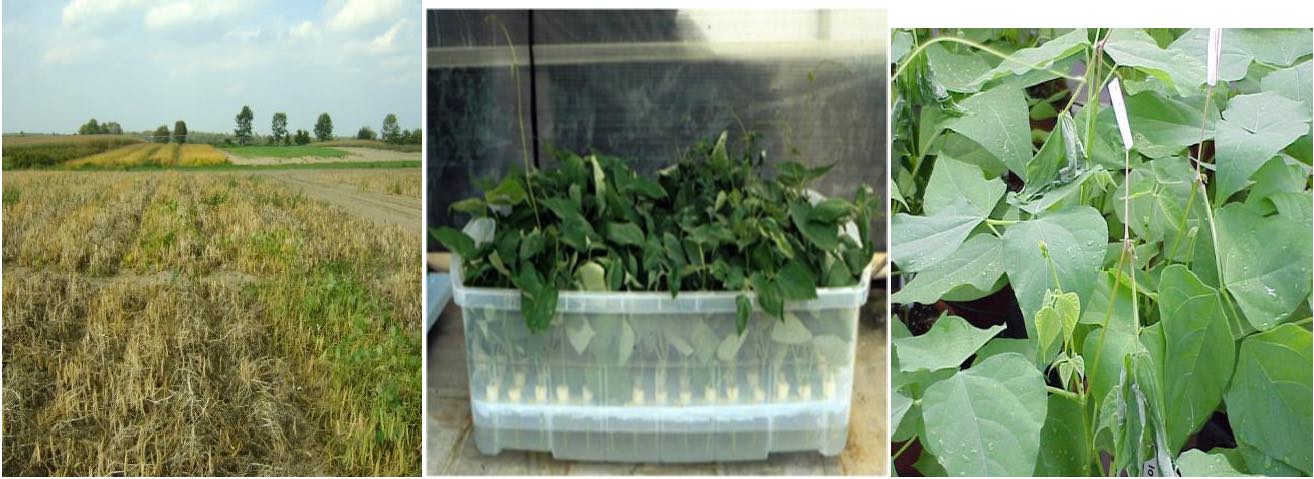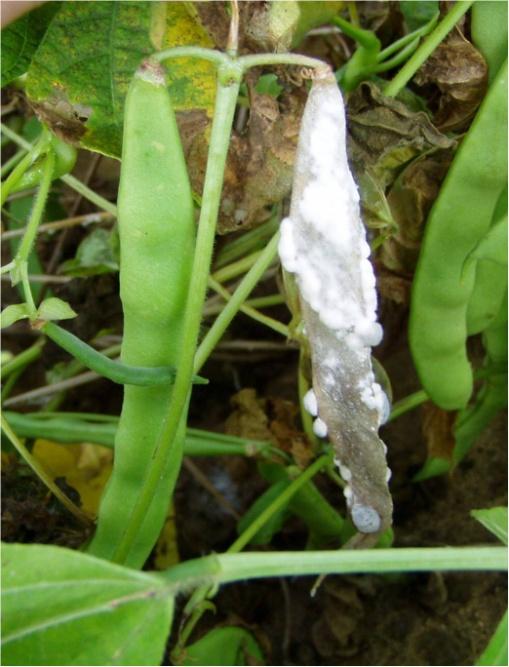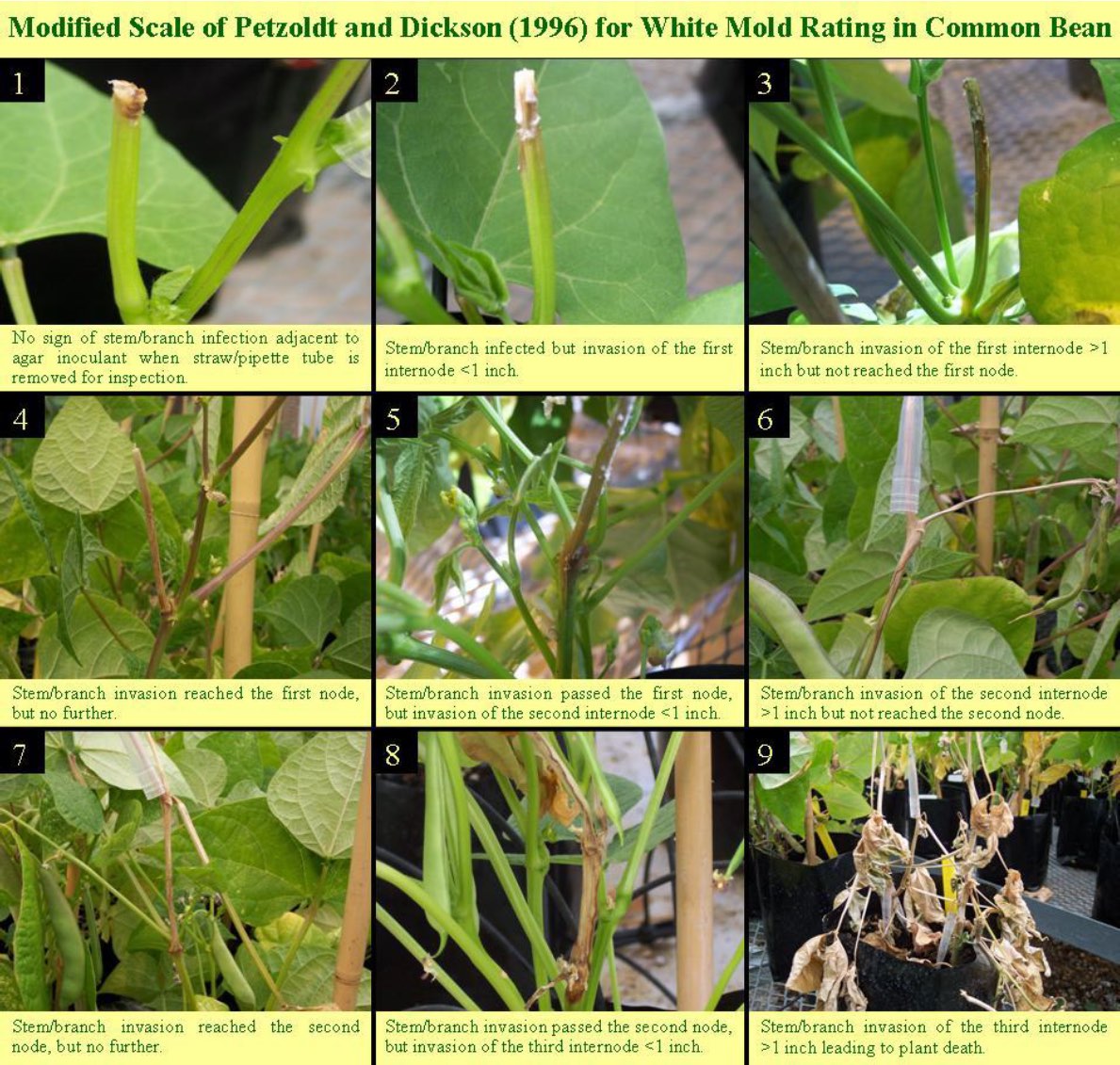White Mold
Preamble: White mold, caused by Sclerotinia sclerotiorum is one of the most serious diseases that reduce bean seed yields and quality in Michigan. Breeding for resistance is a major focus of the MSU bean program. Resistance to white mold is complicated by interaction with plant architectural traits and variable environmental conditions. The focus of the breeding program has been to combine plant architecture avoidance traits with levels of partial physiological resistance available in bean germplasm. Miklas et al. (2013) generated a comparative map composed of 79 quantitative trait loci (QTL) for white mold resistance (27), disease avoidance traits (36) and root traits (16). Thirteen white mold resistance QTL, six with strong and seven with weak associations with disease avoidance traits, were observed. Root length and lodging QTL co-located in three regions. Canopy porosity and height, and lodging were highly correlated with disease severity score in field screening trials conducted from 2000 to 2011. Resistance to lodging was extremely important for reducing disease severity in both dry and snap bean. Avoidance traits were less effective in reducing disease severity in trials with heavy disease pressure. Dry bean lines with physiological resistance in combination with disease avoidance traits did not require fungicide application to protect yield potential under moderate and heavy disease pressure. Given the complexity of disease resistance as evidenced by the comparative QTL map, marker-assisted breeding for disease avoidance is not recommended at this time. Instead, selecting for resistance to white mold in the field, in combination with high yield potential and acceptable maturity, is the recommended strategy for improving both disease avoidance and physiological resistance to white mold in cultivars with commercially acceptable agronomic traits.

Figure 1: Screening for reaction to white mold in field using spreader rows under irrigation; lab using oxalate and straw tests. In Michigan, field screening is conducted at the Montcalm research farm using natural inoculation, inter-planting with susceptible varieties and overhead sprinkler irrigation. The field is naturally infested with white mold sclerotia from previous crops and irrigation is provided to supplement natural rainfall during flowering when infection occurs. Two types of greenhouse tests are conducted to measure physiological resistance namely the oxalate test and the straw test. The oxalate test is an indirect screening method of plant wilting which gives comparable ratings to field disease scores. The straw test is widely used by bean breeders to detect resistance in the absence of plant architectural traits that provide disease avoidance in the field.

Figure 2. White Mold on a Bean Pod.
White mold is a major disease of common bean (Phaseolus vulgaris L.) grown in temperate production areas. The objective of this study was to use single nucleotide polymorphism (SNP) markers from the BARCBean6K_3 BeadChip to identify quantitative trait loci (QTL) associated with traits related to white mold resistance in common bean. A recombinant inbred line (RIL) population from a cross of disease tolerant pinto line AN-37 and disease susceptible line P02630 was evaluated in Michigan for four years under white mold pressure. Traits evaluated included disease incidence, the numbers of days to flower, and to maturity, canopy height, lodging, seed yield and 100 seed weight. A linkage map of the RIL population spanning 1,499cM was constructed using 447 SNP markers. The map covered all eleven bean chromosomes with an average distance of 3.6 cM between markers. A total of 13 QTL for agronomic and disease traits were consistently identified in different years. A major QTL WM3.1AN associated with white mold avoidance was validated on chromosome Pv03. The QTL is associated with disease avoidance traits such as canopy porosity, plant height, stay green stem trait, and maturity. QTL for maturity and canopy height also mapped to the same genomic region on Pv03. Finding strong associations between maturity, lodging, canopy height and disease incidence offers alternative strategies to improve levels of white mold avoidance over greenhouse screening. The validation of the WM3.1AN, AP630 QTL for white mold avoidance should provide bean breeders with the opportunity to introgress avoidance traits into their germplasm.
Abstracted from: Hoyos-Villegas, V., W. Mkwaila, P.B. Cregan and J.D. Kelly. 2015. QTL analysis of white mold avoidance in pinto bean (Phaseolus vulgaris). Crop Sci. 55:2116-2129. doi:10.2135/cropsci2015.02.0106.011.01876.x
Previous publications:
Kolkman, J.M. and J.D. Kelly. 2002. Agronomic traits affecting resistance to white mold in common bean Crop Sci. 42:693-699.
Kolkman, J.M. and J.D. Kelly. 2003. QTL conferring resistance and avoidance to white mold (Sclerotinia sclerotiorum) in common bean (Phaseolus vulgaris). Crop Sci. 43:539-548.
Ender, M. and J.D. Kelly. 2005. Identification of QTL associated with white mold resistance in common bean. Crop Sci. 45:2482-2490.
Miklas, P.N., L. D. Porter, J. D. Kelly, and J. R. Myers 2013. Characterization of white mold disease avoidance in common bean. European J. Plant Pathology. 135:525–543. doi:10.1007/s10658-012-0153-8.
Miklas, P.N. K.F. Grafton, D. Hauf, and J. D. Kelly. 2006. Registration of partial white mold resistant pinto bean germplasm line USPT-WM-1. Crop Sci. 46: 2339.
Ender, M., K. Terpstra, and J.D. Kelly. 2008. Marker-assisted selection for white mold resistancein common bean. Mol. Breed. 21:149-157.
Mkwaila, W., K.A. Terpstra, M. Ender, and J.D. Kelly. 2011. Identification of QTL for resistance to white mold in wild and landrace germplasm of common bean. Plant Breeding doi:10.1111/j.1439-0523.2011.01876.x

Figure 3: Straw test - modified by Shree Singh at University of Idaho [Petzoldt, R., and M.H. Dickson. 1996. Straw test for resistance to white mold in beans. Annu. Rep. Bean Improv. Coop. 39:142-143.]



 Print
Print Email
Email